Process-Structure-Property Relationships of AISI H13 Tool Steel Processed with Selective Laser Melting
Abstract
:1. Introduction
2. Experimental Procedures
2.1. Powder Material
2.2. SLM Processing Parameters
2.3. Sample Characterization Methods
3. Results and Discussion
3.1. Density Behavior
3.2. Cracking Behavior
3.3. Surface Roughness
3.4. Microstructural Analysis
3.5. Hardness
4. Conclusions
- The relative density of the as-built material, processed with and without preheating of 200 °C, increased non-linearly with increasing the volumetric energy density up to a value of about 60 J/mm3 and then no significant increase was seen.
- The relative densities of the samples processed with preheating were relatively higher when compared with those of the non-preheated samples; a relative density of 99.7% was achieved.
- Application of the preheating process, not only enhanced the relative density, but also it helped in eliminating the thermally-induced cracks. In fact, preheating of the base plate broadens the safe processing window of SLM-manufactured H13 tool steel.
- The best surface roughness achieved in this work was 6.1 µm, corresponding to the sample B5 (P = 200 W, v = 600 mm/s, and h = 80 µm). Due to un-melted powders, further improvements in the surface roughness was not possible and parts need to go through post-processing in case better finishes are required.
- The microstructure of the as-built samples showed fine equiaxed cellular-dendritic structure (600 nm up to 1µm). All the samples studied showed both a dominant martensite and varying retained austenite contents. The preheating temperature of 200 °C led to an increase in the amount of retained austenite. For example, the amount of retained austenite in a preheating sample PC9 was found to be 66% higher when compared to that of the non-preheated sample C9.
- The microhardness of the as-built samples was found to vary from 650 to 689 HV 0.2, which is comparable to a conventionally produced H13 tool steel.
Author Contributions
Funding
Acknowledgments
Conflicts of Interest
References
- Brandt, M. Laser Additive Manufacturing: Materials, Design, Technologies, and Applications; Brandt, M., Ed.; Woodhead Publishing: Amsterdam, The Netherlands, 2016. [Google Scholar]
- Yap, C.Y.; Chua, C.K.; Dong, Z.L.; Liu, Z.H.; Zhang, D.Q.; Loh, L.E.; Sing, S.L. Review of selective laser melting: Materials and applications. Appl. Phys. Rev. 2015, 2, 041101. [Google Scholar] [CrossRef]
- Mazur, M.; Brincat, P.; Leary, M.; Brandt, M. Numerical and experimental evaluation of a conformally cooled H13 steel injection mould manufactured with selective laser melting. Int. J. Adv. Manuf. Technol. 2017, 93, 881–900. [Google Scholar] [CrossRef]
- Armillotta, A.; Baraggi, R.; Fasoli, S. SLM tooling for die casting with conformal cooling channels. Int. J. Adv. Manuf. Technol. 2014, 71, 573–583. [Google Scholar] [CrossRef]
- Mazur, M.; Leary, M.; McMillan, M.; Elambasseril, J.; Brandt, M. SLM additive manufacture of H13 tool steel with conformal cooling and structural lattices. Rapid Prototyp. J. 2016, 22, 504–518. [Google Scholar] [CrossRef]
- Khairallah, S.A.; Anderson, A.T.; Rubenchik, A.; King, W.E. Laser powder-bed fusion additive manufacturing: Physics of complex melt flow and formation mechanisms of pores, spatter, and denudation zones. Acta Mater. 2016, 108, 36–45. [Google Scholar] [CrossRef] [Green Version]
- Martin, J.H.; Yahata, B.D.; Hundley, J.M.; Mayer, J.A.; Schaedler, T.A.; Pollock, T.M. 3D printing of high-strength aluminium alloys. Nature 2017, 549, 365–369. [Google Scholar] [CrossRef]
- Tan, C.; Zhou, K.; Ma, W.; Zhang, P.; Liu, M.; Kuang, T. Microstructural evolution, nanoprecipitation behavior and mechanical properties of selective laser melted high-performance grade 300 maraging steel. Mater. Des. 2017, 134, 23–34. [Google Scholar] [CrossRef]
- Mutua, J.; Nakata, S.; Onda, T.; Chen, Z.C. Optimization of selective laser melting parameters and influence of post heat treatment on microstructure and mechanical properties of maraging steel. Mater. Des. 2018, 139, 486–497. [Google Scholar] [CrossRef]
- Bodziak, S.; Al-Rubaie, K.S.; Valentina, L.D.; Lafratta, F.H.; Santos, E.C.; Zanatta, A.M.; Chen, Y. Precipitation in 300 grade maraging steel built by selective laser melting: Aging at 510 °C for 2 h. Mater. Charact. 2019, 151, 73–83. [Google Scholar] [CrossRef]
- Kempen, K.; Vrancken, B.; Buls, S.; Thijs, L.; Van Humbeeck, J.; Kruth, J.-P. Selective Laser Melting of Crack-Free High Density M2 High Speed Steel Parts by Baseplate Preheating. J. Manuf. Sci. Eng. 2014, 136, 61026. [Google Scholar] [CrossRef]
- Huber, F.; Bischof, C.; Hentschel, O.; Heberle, J.; Zettl, J.; Nagulin, K.Y.; Schmidt, M. Laser beam melting and heat-treatment of 1.2343 (AISI H11) tool steel – microstructure and mechanical properties. Mater. Sci. Eng. A. 2019, 742, 109–115. [Google Scholar] [CrossRef]
- Hentschel, O.; Scheitler, C.; Fedorov, A.; Junker, D.; Gorunov, A.; Haimerl, A.; Merklein, M.; Schmidt, M. Experimental investigations of processing the high carbon cold-work tool steel 1.2358 by laser metal deposition for the additive manufacturing of cold forging tools. J. Laser Appl. 2017, 29. [Google Scholar] [CrossRef]
- Sander, J.; Hufenbach, J.; Giebeler, L.; Wendrock, H.; Kühn, U.; Eckert, J. Microstructure and properties of FeCrMoVC tool steel produced by selective laser melting. Mater. Des. 2016, 89, 335–341. [Google Scholar] [CrossRef]
- Boes, J.; Röttger, A.; Mutke, C.; Escher, C.; Theisen, W. Microstructure and mechanical properties of X65MoCrWV3-2 cold-work tool steel produced by selective laser melting. Addit. Manuf. 2018, 23, 170–180. [Google Scholar] [CrossRef]
- Casati, R.; Coduri, M.; Lecis, N.; Andrianopoli, C.; Vedani, M. Microstructure and mechanical behavior of hot-work tool steels processed by Selective Laser Melting. Mater. Charact. 2018, 137, 50–57. [Google Scholar] [CrossRef]
- Mertens, R.; Vrancken, B.; Holmstock, N.; Kinds, Y.; Kruth, J.-P.; Van Humbeeck, J. Influence of Powder Bed Preheating on Microstructure and Mechanical Properties of H13 Tool Steel SLM Parts. Phys. Procedia 2016, 83, 882–890. [Google Scholar] [CrossRef] [Green Version]
- DebRoy, T.; Wei, H.L.; Zuback, J.S.; Mukherjee, T.; Elmer, J.W.; Milewski, J.O.; Beese, A.M.; Wilson-Heid, A.; De, A.; Zhang, W. Additive manufacturing of metallic components – Process, structure and properties. Prog. Mater. Sci. 2018, 92, 112–224. [Google Scholar] [CrossRef]
- Krell, J.; Röttger, A.; Geenen, K.; Theisen, W. General investigations on processing tool steel X40CrMoV5-1 with selective laser melting. J. Mater. Process. Technol. 2018, 255, 679–688. [Google Scholar] [CrossRef]
- Yan, J.J.; Zheng, D.L.; Li, H.X.; Jia, X.; Sun, J.F.; Li, Y.L.; Qian, M.; Yan, M. Selective laser melting of H13: Microstructure and residual stress. J. Mater. Sci. 2017, 52, 12476–12485. [Google Scholar] [CrossRef]
- Laakso, P.; Riipinen, T.; Laukkanen, A.; Andersson, T.; Jokinen, A.; Revuelta, A.; Ruusuvuori, K. Optimization and simulation of SLM process for high density H13 tool steel parts. Phys. Procedia. 2016, 83, 26–35. [Google Scholar] [CrossRef]
- Holzweissig, M.J.; Taube, A.; Brenne, F.; Schaper, M.; Niendorf, T. Microstructural Characterization and Mechanical Performance of Hot Work Tool Steel Processed by Selective Laser Melting. Metall. Mater. Trans. B. 2015, 46, 545–549. [Google Scholar] [CrossRef]
- Wang, M.; Li, W.; Wu, Y.; Li, S.; Cai, C.; Wen, S.; Wei, Q.; Shi, Y.; Ye, F.; Chen, Z. High-Temperature Properties and Microstructural Stability of the AISI H13 Hot-Work Tool Steel Processed by Selective Laser Melting. Metall. Mater. Trans. B. 2019, 50.1, 531–542. [Google Scholar] [CrossRef]
- Yakout, M.; Cadamuro, A.; Elbestawi, M.A.; Veldhuis, S.C. The selection of process parameters in additive manufacturing for aerospace alloys. Int. J. Adv. Manuf. Technol. 2017, 92, 2081–2098. [Google Scholar] [CrossRef]
- Attallah, M.M.; Jennings, R.; Wang, X.; Carter, L.N. Additive manufacturing of Ni-based superalloys: The outstanding issues. MRS Bull. 2016, 41, 758–764. [Google Scholar] [CrossRef]
- Peng, T.; Chen, C. Influence of energy density on energy demand and porosity of 316L stainless steel fabricated by selective laser melting. Int. J. Precis. Eng. Manuf. - Green Technol. 2018, 5, 55–62. [Google Scholar] [CrossRef]
- Carlton, H.D.; Haboub, A.; Gallegos, G.F.; Parkinson, D.Y.; MacDowell, A.A. Damage evolution and failure mechanisms in additively manufactured stainless steel. Mater. Sci. Eng. A. 2016, 651, 406–414. [Google Scholar] [CrossRef] [Green Version]
- Aboulkhair, N.T.; Everitt, N.M.; Ashcroft, I.; Tuck, C. Reducing porosity in AlSi10Mg parts processed by selective laser melting. Addit. Manuf. 2014, 1, 77–86. [Google Scholar] [CrossRef]
- Fu, C.; Guo, Y. 3-dimensional finite element modeling of selective laser melting Ti-6Al-4V alloy. Proceedings of the 25th Annual International Solid Freeform Fabrication Symposium 1129–1144.
- Mumtaz, K.; Hopkinson, N. Selective laser melting of Inconel 625 using pulse shaping. Rapid Prototyp. J. 2010, 16, 248–257. [Google Scholar] [CrossRef] [Green Version]
- Gu, D.; Shen, Y. Balling phenomena in direct laser sintering of stainless steel powder: Metallurgical mechanisms and control methods. Mater. Des. 2009, 30, 2903–2910. [Google Scholar] [CrossRef]
- Kruth, J.P.; Froyen, L.; Van Vaerenbergh, J.; Mercelis, P.; Rombouts, M.; Lauwers, B. Selective laser melting of iron-based powder. J. Mater. Process. Technol. 2004, 149, 616–622. [Google Scholar] [CrossRef]
- Strano, G.; Hao, L.; Everson, R.M.; Evans, K.E. Surface roughness analysis, modelling and prediction in selective laser melting. J. Mater. Process. Technol. 2013, 213, 589–597. [Google Scholar] [CrossRef]
- Yang, T.; Liu, T.; Liao, W.; MacDonald, E.; Wei, H.; Chen, X.; Jiang, L. The influence of process parameters on vertical surface roughness of the AlSi10Mg parts fabricated by selective laser melting. J. Mater. Process. Technol. 2019, 266, 26–36. [Google Scholar] [CrossRef]
- Maamoun, A.H.; Xue, Y.F.; Elbestawi, M.A.; Veldhuis, S.C. Effect of selective laser melting process parameters on the quality of al alloy parts: Powder characterization, density, surface roughness, and dimensional accuracy. Materials 2018, 11, 2343. [Google Scholar] [CrossRef] [PubMed]
- Zhong, Y.; Liu, L.; Wikman, S.; Cui, D.; Shen, Z. Intragranular cellular segregation network structure strengthening 316L stainless steel prepared by selective laser melting. J. Nucl. Mater. 2016, 470, 170–178. [Google Scholar] [CrossRef]
- Thijs, L.; Montero Sistiaga, M.L.; Wauthle, R.; Xie, Q.; Kruth, J.P.; Van Humbeeck, J. Strong morphological and crystallographic texture and resulting yield strength anisotropy in selective laser melted tantalum. Acta Mater. 2013, 61, 4657–4668. [Google Scholar] [CrossRef] [Green Version]
- Attar, H.; Ehtemam-Haghighi, S.; Kent, D.; Okulov, I.V.; Wendrock, H.; Bönisch, M.; Volegov, A.S.; Calin, M.; Eckert, J.; Dargusch, M.S. Nanoindentation and wear properties of Ti and Ti-TiB composite materials produced by selective laser melting. Mater. Sci. Eng. A 2017, 688, 20–26. [Google Scholar] [CrossRef] [Green Version]
- Keist, J.S.; Palmer, T.A. Development of strength-hardness relationships in additively manufactured titanium alloys. Mater. Sci. Eng. A. 2017, 693, 214–224. [Google Scholar] [CrossRef] [Green Version]
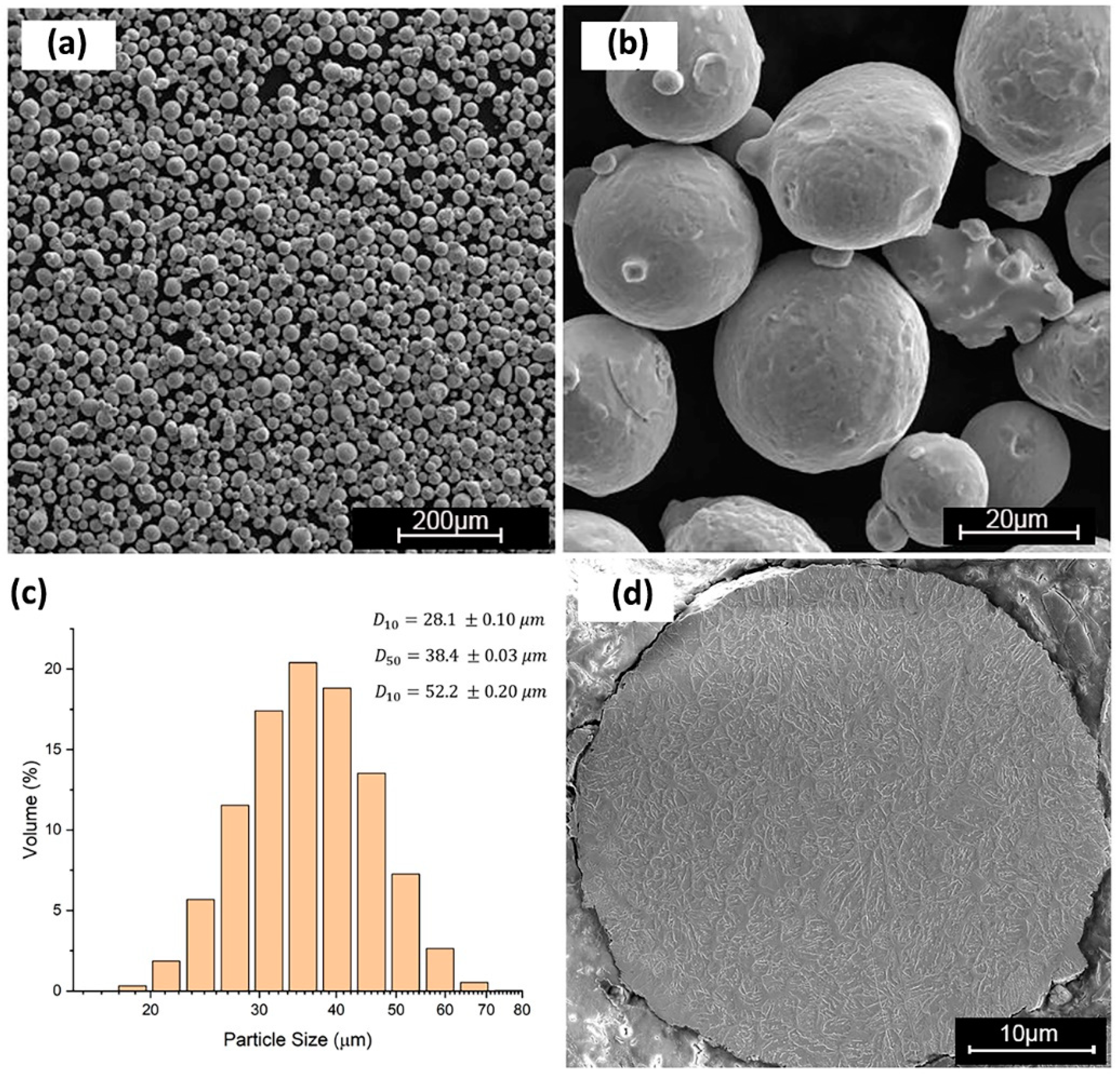
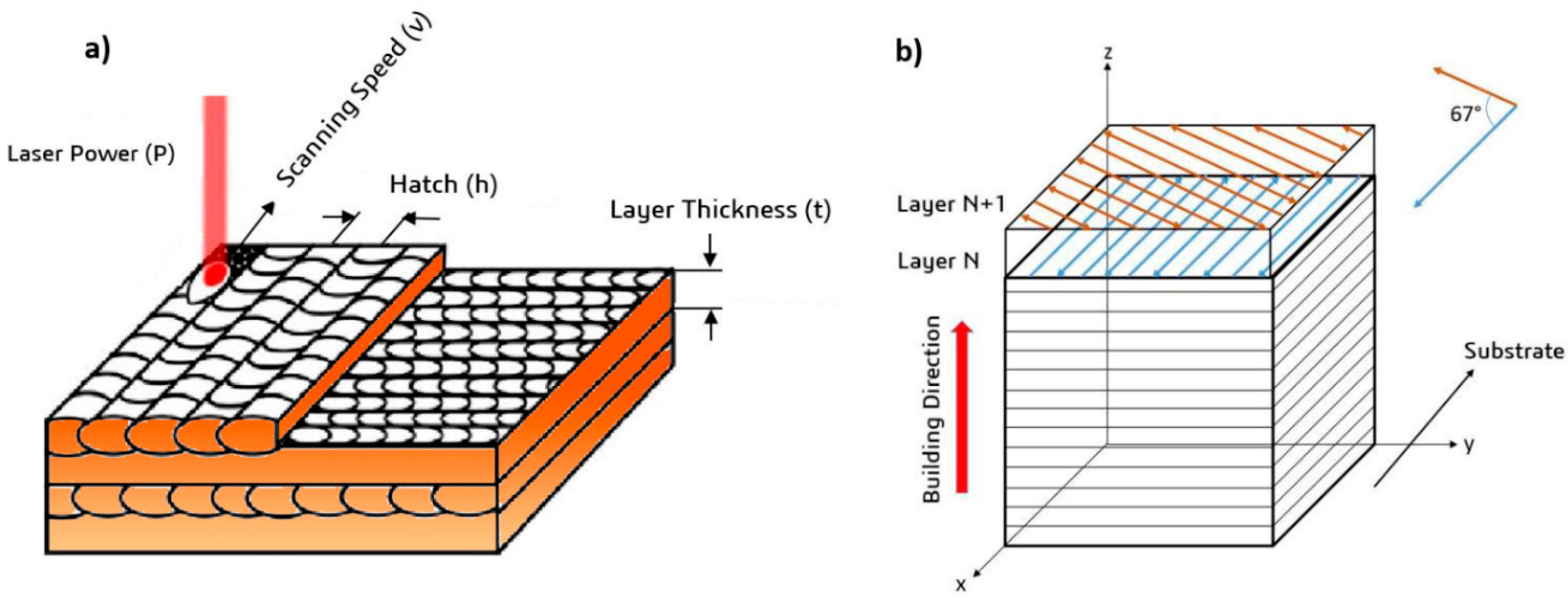
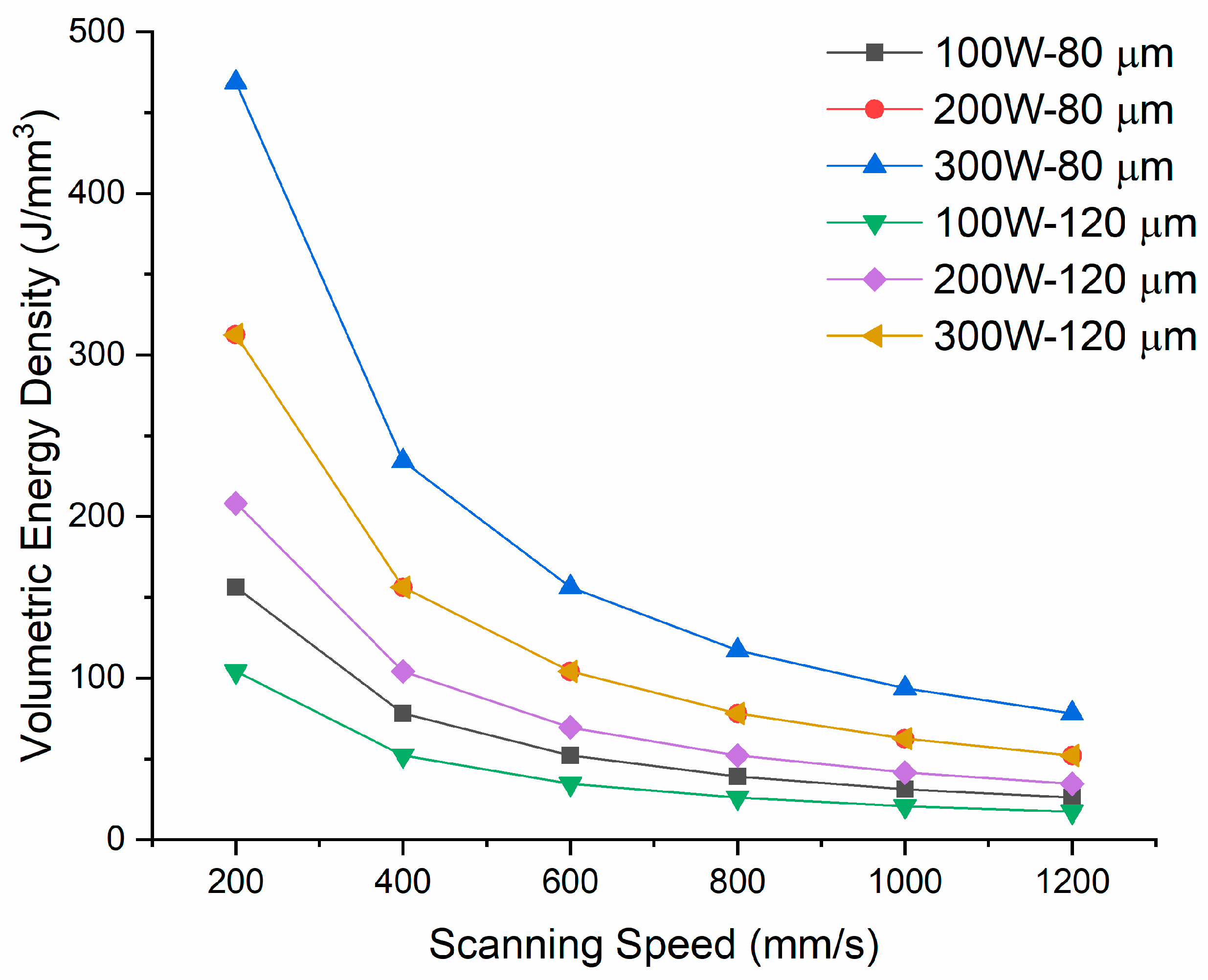
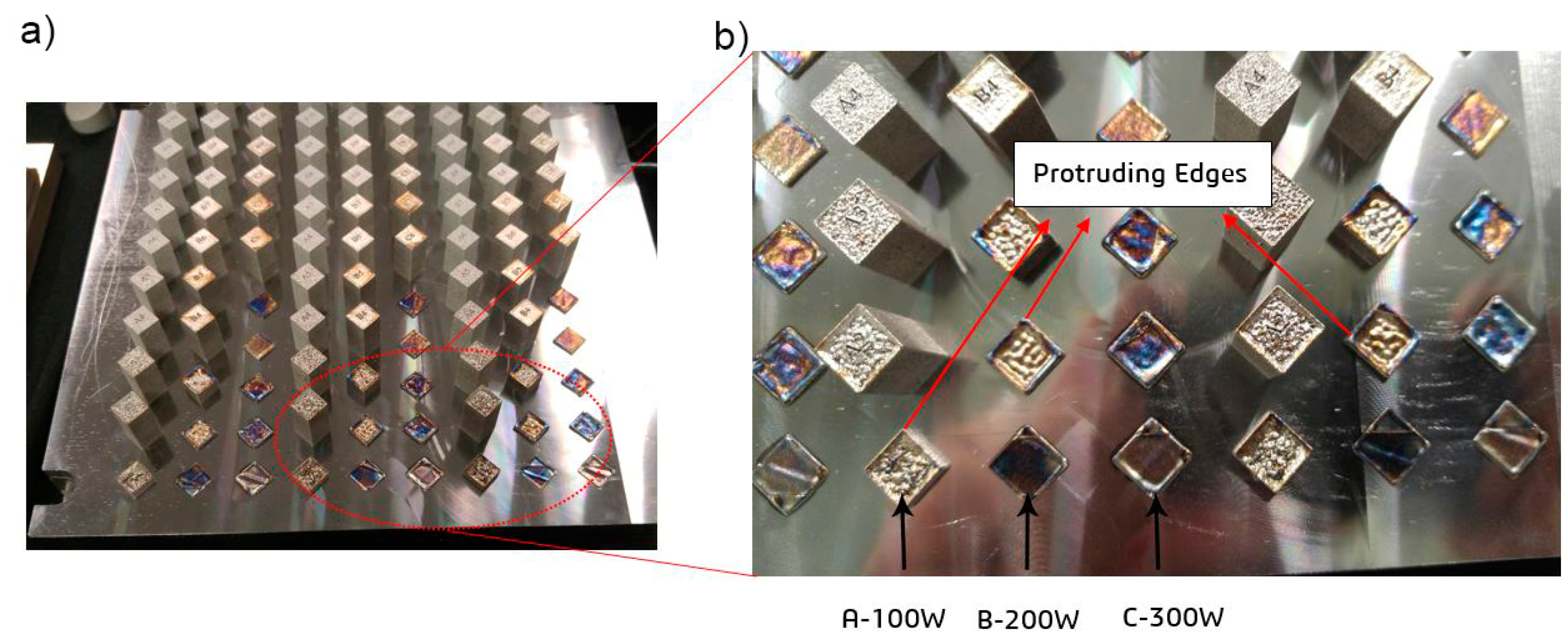

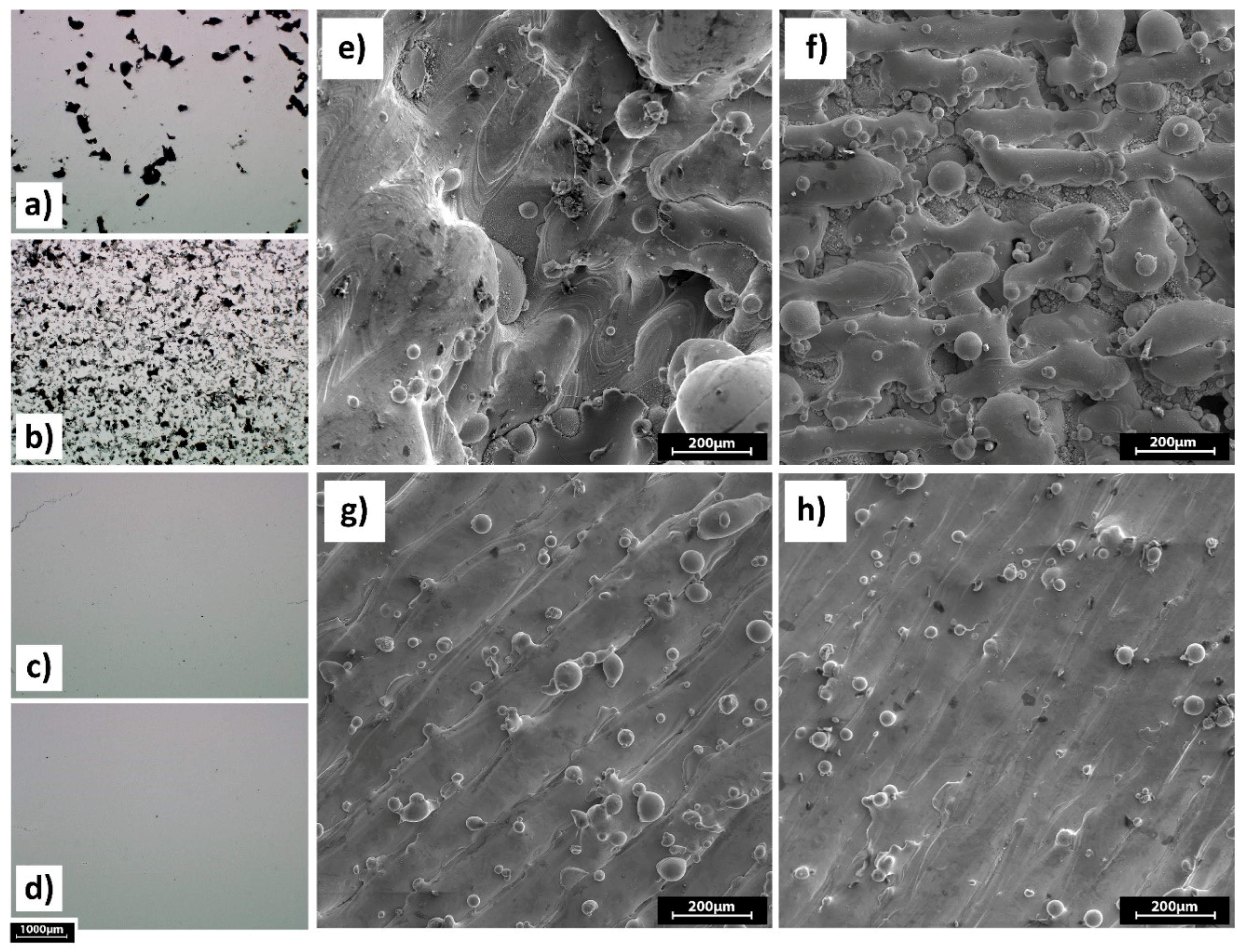
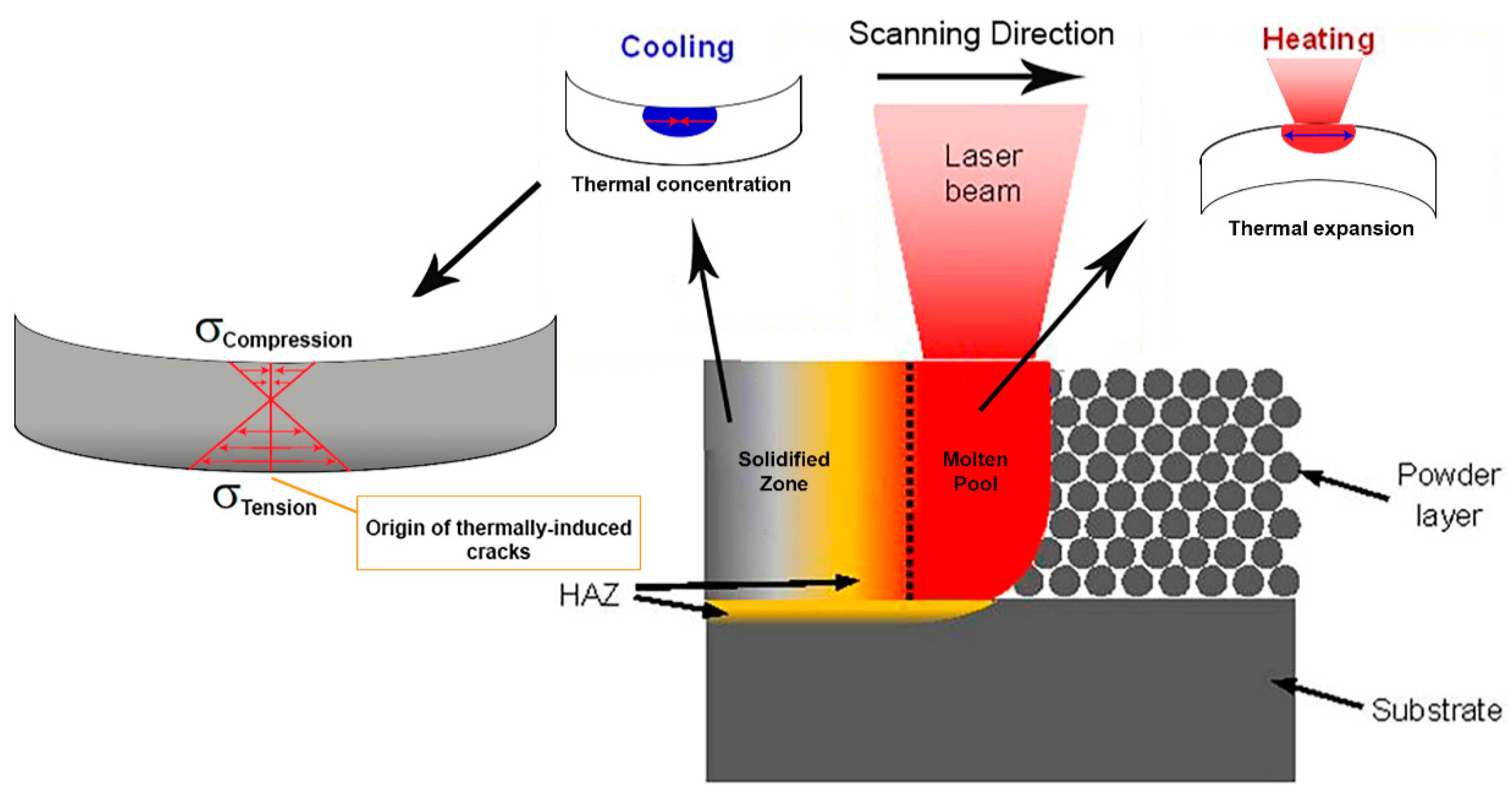
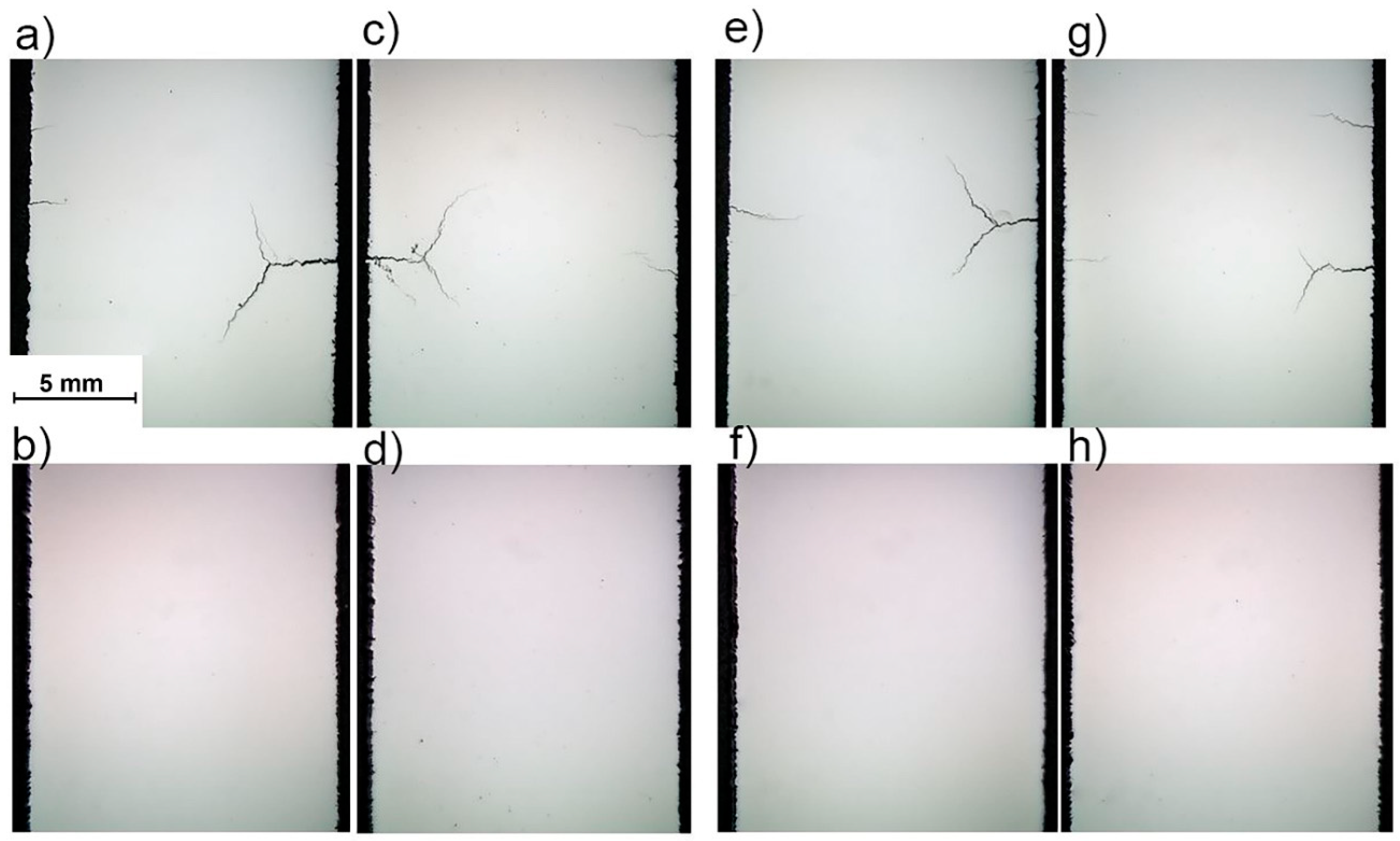
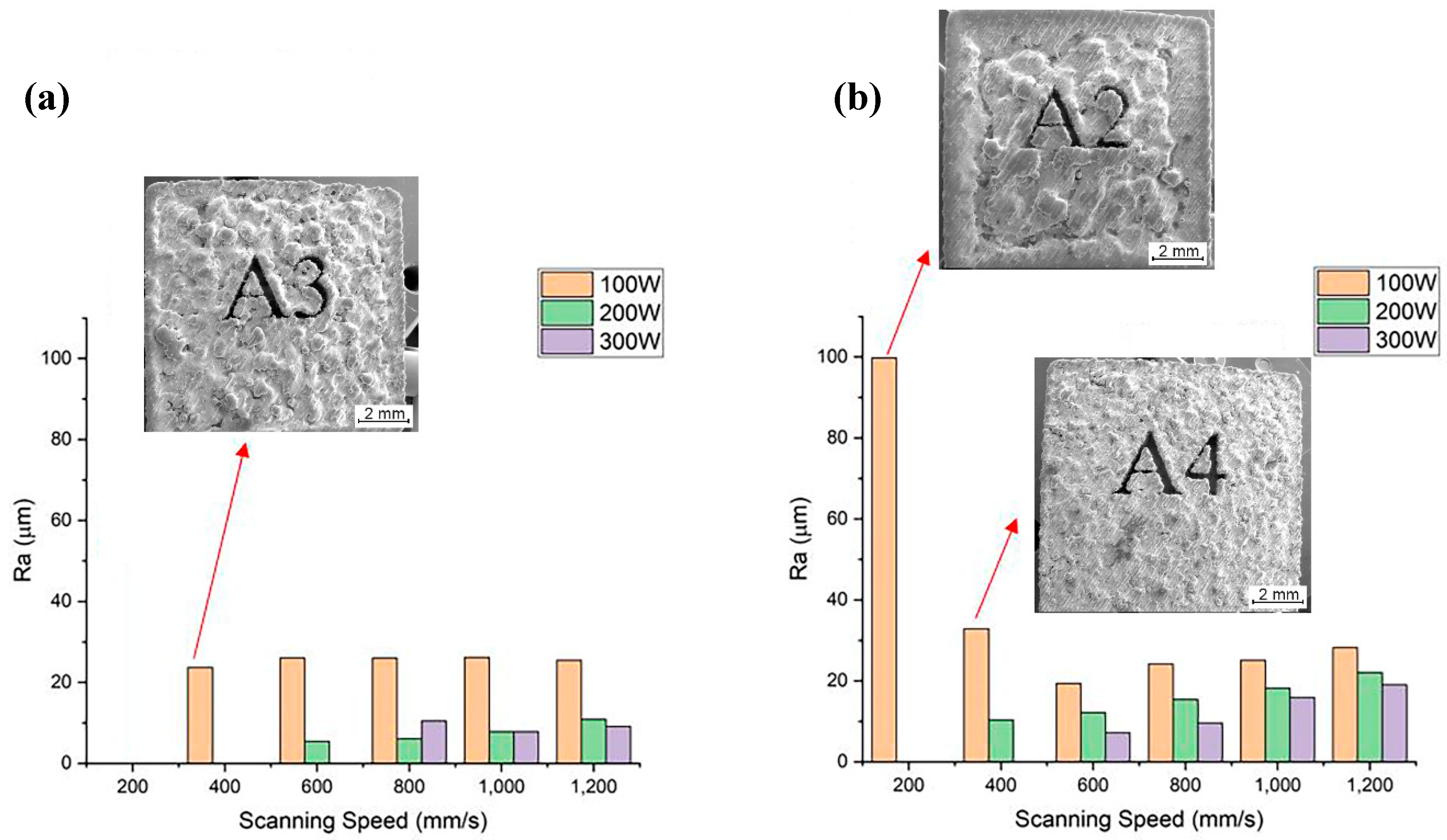

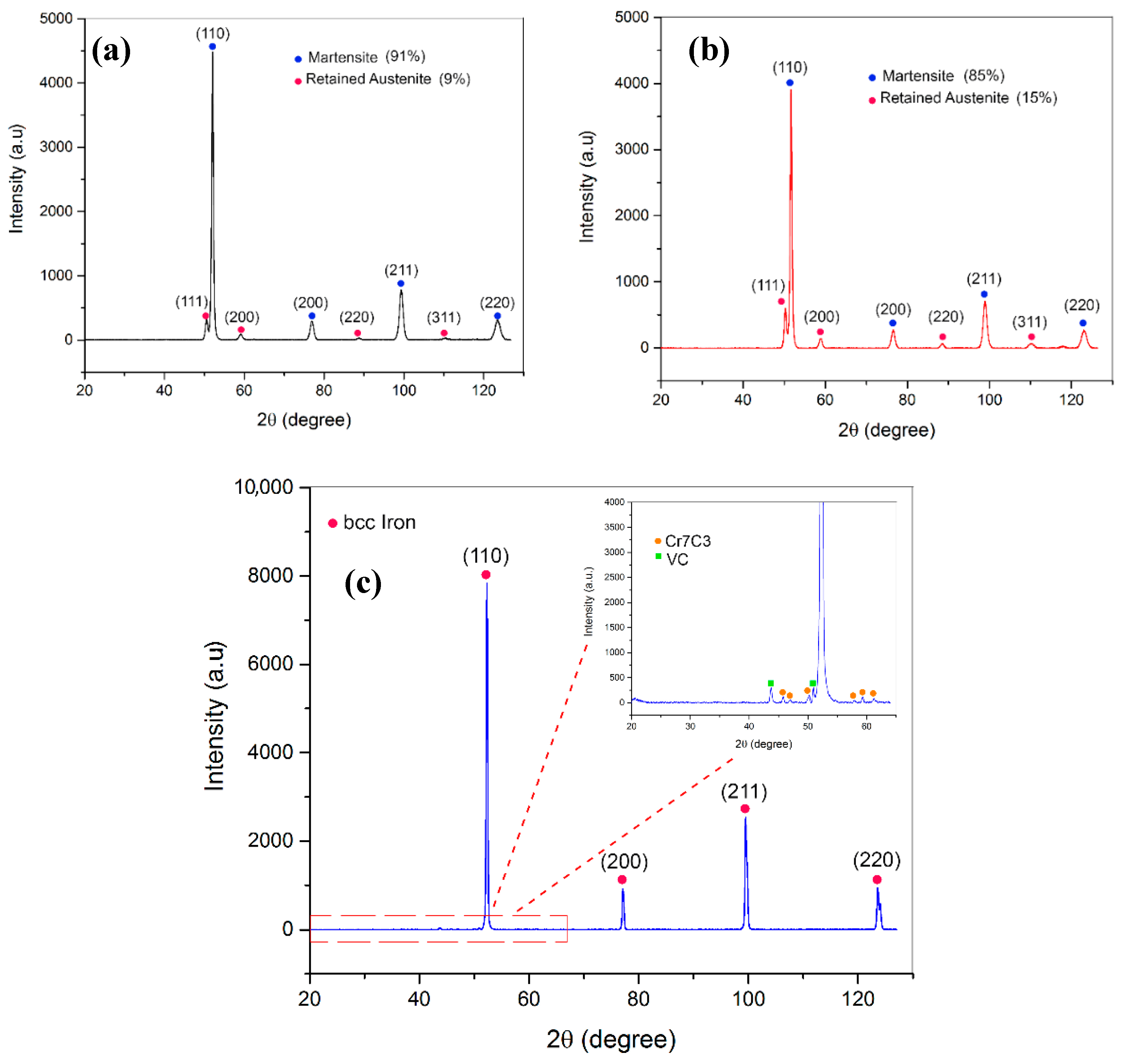


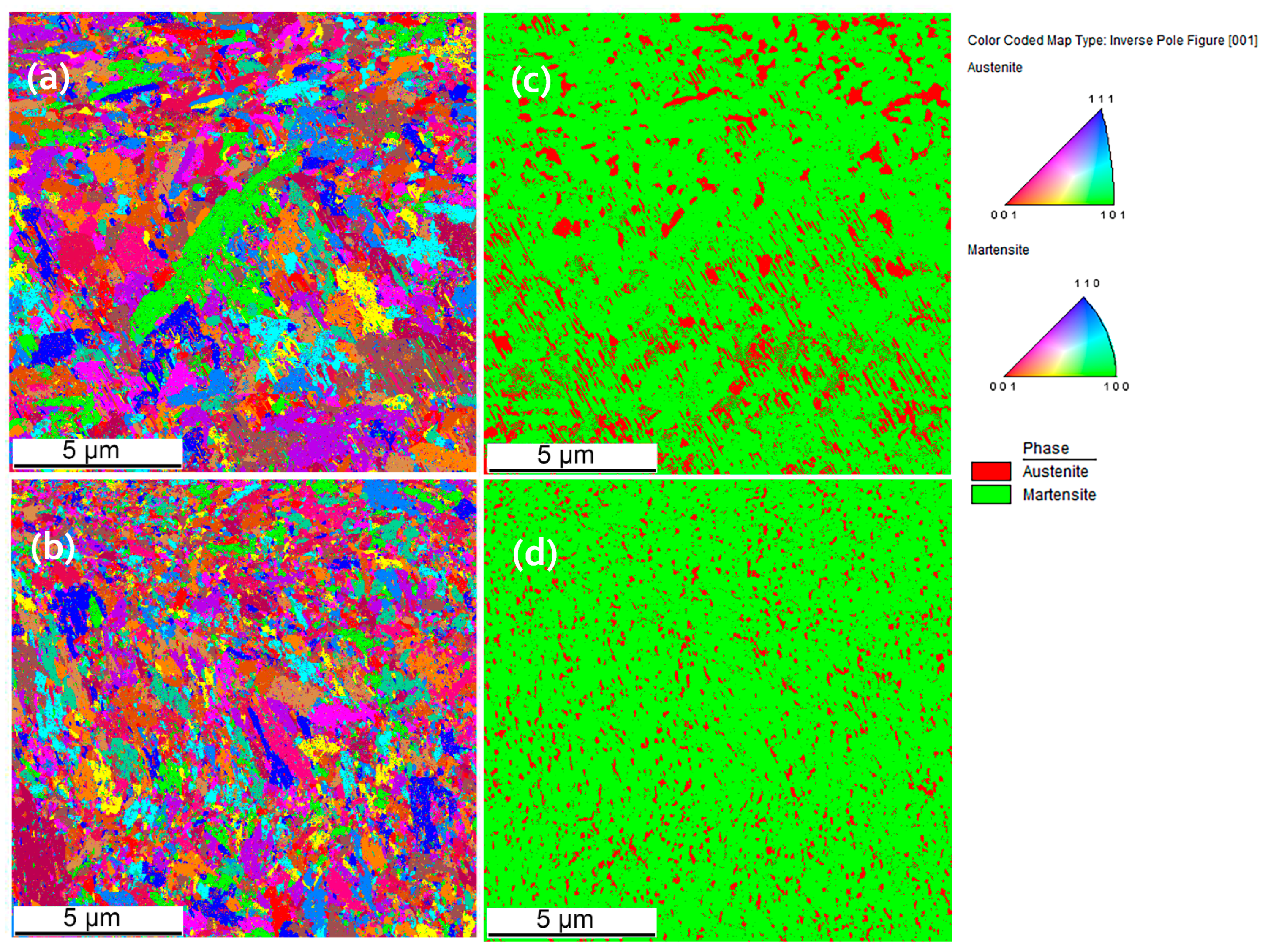
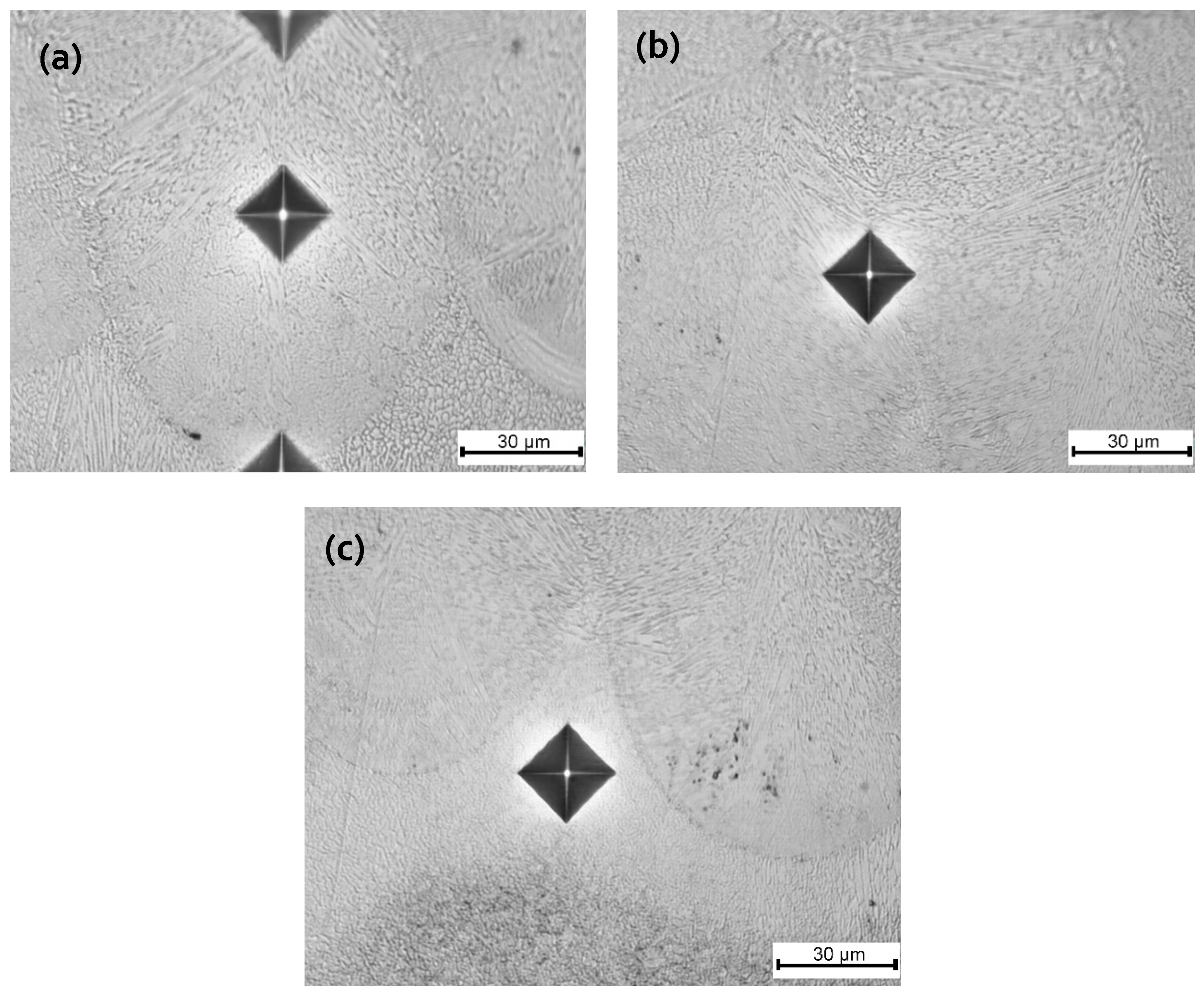
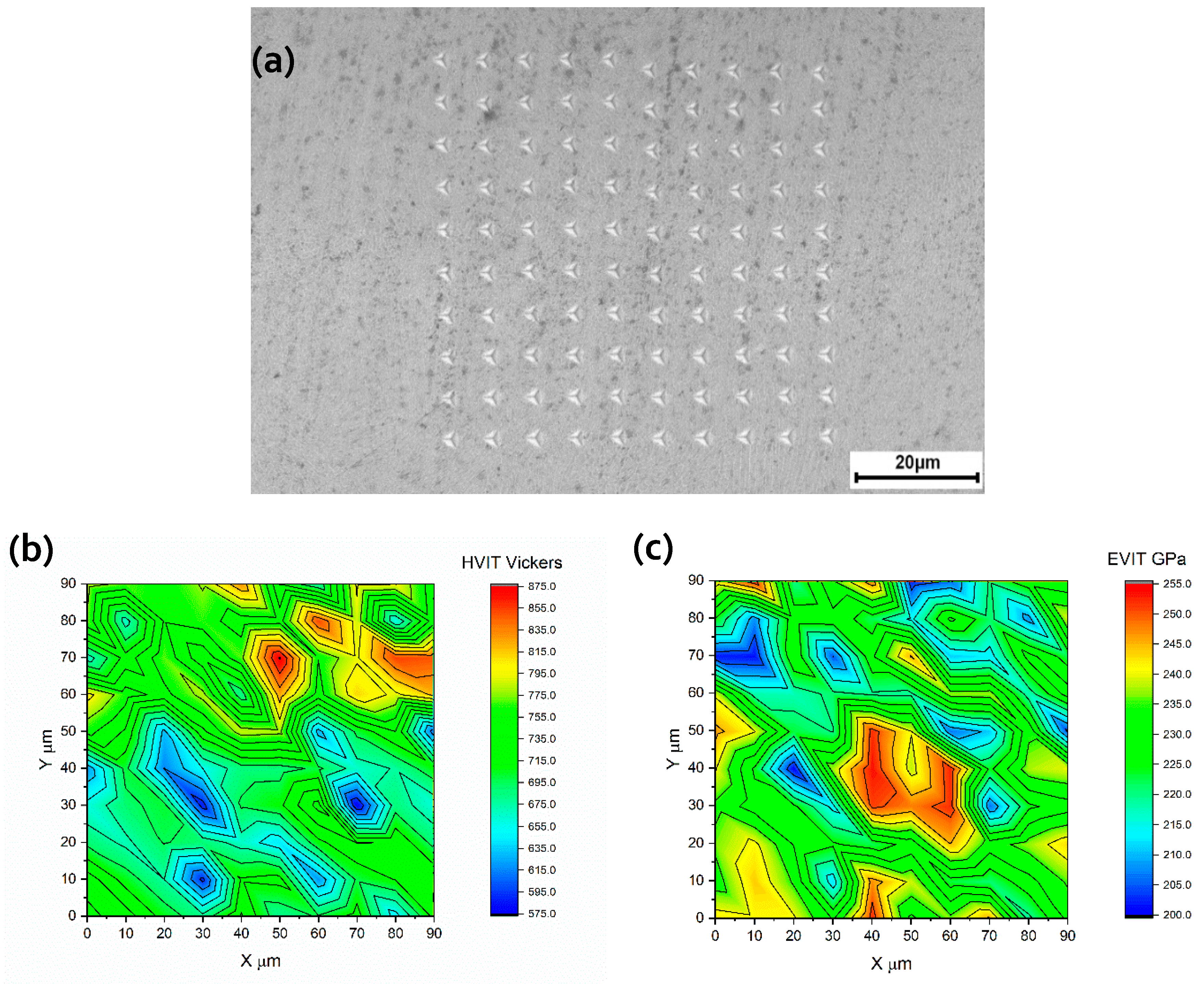
| Machine | Process Parameters | Sample Size (mm3) | Remarks | Reference |
|---|---|---|---|---|
| Realizer II SLM MCP HEK | P = 100 W, v = 200–400 mm/s, point distance = 30 µm, layer thickness = 30 µm, hatch exposure time = 75–100 µs, Preheating = 100–300 °C | 5 × 5 × 10 | Porosity and density measurements, heat-treatment post processing | [19] |
| SLM Solutions 250 HL | P = 150 W, v = 300 mm/s, hatch spacing = 50 µm, Preheating of 200 °C, | 10 × 10 × 10 | Microstructural characterization, residual stress measurements | [20] |
| SLM Solutions 250 HL | P = 100–300 W, v = 400–1200 mm/s, hatch spacing = 90–150 µm, | 10 × 10 × 10 | Density optimization with D-optimal design of experiment | [21] |
| In-house developed SLM | P = 170 W, v = 400, 800 mm/s, hatch spacing = 105 µm, layer thickness = 30 µm | 10 × 10 × 10 | Influence of preheating at 100, 200, 300, and 400 °C on the status of residual stresses, and mechanical properties | [17] |
| SLM Solutions 250 HL | P = 175 W, v = 750 mm/s, hatch spacing = 120 µm, layer thickness = 30 µm. | 8 × 3 × 1.5 | Microstructural characterization and interrelationship between process parameters and microstructural evolution | [22] |
| SLM Solutions 250 HL | P = 125–375 W, v = 289–2604 mm/s, hatch spacing = 120 µm, Layer thickness = 30 µm | 4 × 4 × 4 | Density optimization and manufacturability of self-supporting conformal cooling channels | [5] |
| EOS M280 SLM | P = 280 W, v = 980 mm/s, hatch spacing = 120 µm, layer thickness = 40 µm. | 10 × 10 × 3 | Microstructural characterization and effect of post-processing heat treatment on the microstructure of the as-build samples | [23] |
| Element (wt %) | Cr | Mo | Si | V | Mn | C | Fe |
|---|---|---|---|---|---|---|---|
| ASTM-A681 | 4.75–5.5 | 1.10–1.75 | 0.8–1.25 | 0.8–1.2 | 0.2–0.6 | 0.32–0.45 | Bal. |
| Reported by Supplier | 5.36 | 1.38 | 1.12 | 1.05 | 0.42 | 0.39 | Bal. |
| ICP-OES | 5.27 | 1.34 | 1.08 | 0.97 | 0.40 | 0.39 | Bal. |
| Sample Code | P (W) | v (mm/s) | h (µm) | Sample Code | P (W) | v (mm/s) | h (µm) | Sample Code | P (W) | v (mm/s) | h (µm) |
|---|---|---|---|---|---|---|---|---|---|---|---|
| A1 | 100 | 200 | 80 | B1 | 200 | 200 | 80 | C1 | 300 | 200 | 80 |
| A2 | 100 | 200 | 120 | B2 | 200 | 200 | 120 | C2 | 300 | 200 | 120 |
| A3 | 100 | 400 | 80 | B3 | 200 | 400 | 80 | C3 | 300 | 400 | 80 |
| A4 | 100 | 400 | 120 | B4 | 200 | 400 | 120 | C4 | 300 | 400 | 120 |
| A5 | 100 | 600 | 80 | B5 | 200 | 600 | 80 | C5 | 300 | 600 | 80 |
| A6 | 100 | 600 | 120 | B6 | 200 | 600 | 120 | C6 | 300 | 600 | 120 |
| A7 | 100 | 800 | 80 | B7 | 200 | 800 | 80 | C7 | 300 | 800 | 80 |
| A8 | 100 | 800 | 120 | B8 | 200 | 800 | 120 | C8 | 300 | 800 | 120 |
| A9 | 100 | 1000 | 80 | B9 | 200 | 1000 | 80 | C9 | 300 | 1000 | 80 |
| A10 | 100 | 1000 | 120 | B10 | 200 | 1000 | 120 | C10 | 300 | 1000 | 120 |
| A11 | 100 | 1200 | 80 | B11 | 200 | 1200 | 80 | C11 | 300 | 1200 | 80 |
| A12 | 100 | 1200 | 120 | B12 | 200 | 1200 | 120 | C12 | 300 | 1200 | 120 |
| Element | Point 1 | Point 2 | Point 3 | Point 4 | Point 5 | Point 6 |
|---|---|---|---|---|---|---|
| C | 6.17 | 7.42 | 5.84 | 7.58 | 6.17 | 7.24 |
| Si | 0.92 | 1.01 | 1.01 | 0.9 | 0.99 | 1.02 |
| V | 1.06 | 1.00 | 1.13 | 1.01 | 0.95 | 1.14 |
| Mo | 1.29 | 1.53 | 1.61 | 1.62 | 1.69 | 1.67 |
| Cr | 5.15 | 5.28 | 5.12 | 5.4 | 5.09 | 5.34 |
| Fe | 85.41 | 83.76 | 85.29 | 83.49 | 85.11 | 83.59 |
| Total | 100 | 100 | 100 | 100 | 100 | 100 |
© 2019 by the authors. Licensee MDPI, Basel, Switzerland. This article is an open access article distributed under the terms and conditions of the Creative Commons Attribution (CC BY) license (http://creativecommons.org/licenses/by/4.0/).
Share and Cite
Narvan, M.; Al-Rubaie, K.S.; Elbestawi, M. Process-Structure-Property Relationships of AISI H13 Tool Steel Processed with Selective Laser Melting. Materials 2019, 12, 2284. https://doi.org/10.3390/ma12142284
Narvan M, Al-Rubaie KS, Elbestawi M. Process-Structure-Property Relationships of AISI H13 Tool Steel Processed with Selective Laser Melting. Materials. 2019; 12(14):2284. https://doi.org/10.3390/ma12142284
Chicago/Turabian StyleNarvan, Morteza, Kassim S. Al-Rubaie, and Mohamed Elbestawi. 2019. "Process-Structure-Property Relationships of AISI H13 Tool Steel Processed with Selective Laser Melting" Materials 12, no. 14: 2284. https://doi.org/10.3390/ma12142284





